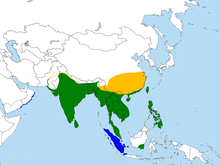
Back عيوق Arabic عيوق ARZ দলমৰা Assamese Muoga (Hydrophasianus) AVK Фазаноопашата якана Bulgarian জল ময়ূর Bengali/Bangla Jakana lost-fazan Breton Jacana cua de faisà Catalan Hydrophasianus chirurgus CEB Jasana cynffonhir Welsh
| Pheasant-tailed jacana | |
|---|---|

| |
| The breeding plumage is marked by the elongated central tail feathers, white front and wing, and the silky golden nape feathers | |
| Scientific classification | |
| Domain: | Eukaryota |
| Kingdom: | Animalia |
| Phylum: | Chordata |
| Class: | Aves |
| Order: | Charadriiformes |
| Family: | Jacanidae |
| Genus: | Hydrophasianus Wagler, 1832 |
| Species: | H. chirurgus
|
| Binomial name | |
| Hydrophasianus chirurgus (Scopoli, 1786)
| |

| |
| Synonyms | |
|
Parra chinensis | |
The pheasant-tailed jacana (Hydrophasianus chirurgus) is a jacana in the monotypic genus Hydrophasianus. Like all other jacanas, they have elongated toes and nails that enable them to walk on floating vegetation in shallow lakes, their preferred habitat. They may also swim or wade in water reaching their body while foraging mainly for invertebrate prey. They are found in tropical Asia from Yemen in the west to the Philippines in the east and move seasonally in parts of their range. They are the only jacanas that migrate long distances and have different non-breeding and breeding plumages. The pheasant-tailed jacana forages by swimming or by walking on aquatic vegetation. Females are larger than males and are polyandrous, laying several clutches that are raised by different males in their harem.
- ^ BirdLife International (2016). "Hydrophasianus chirurgus". IUCN Red List of Threatened Species. 2016: e.T22693543A93411790. doi:10.2305/IUCN.UK.2016-3.RLTS.T22693543A93411790.en. Retrieved 12 November 2021.
- ^ Viscount Walden, Arthur (1877). "A list of the bird known to inhabit the Philippine Archipelago". Transactions of the Zoological Society of London. 9 (2): 125–252. doi:10.1111/j.1096-3642.1875.tb00238.x.
© MMXXIII Rich X Search. We shall prevail. All rights reserved. Rich X Search
